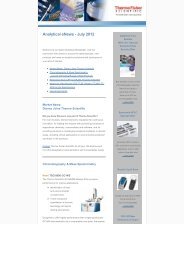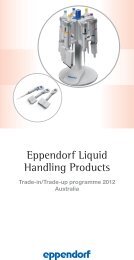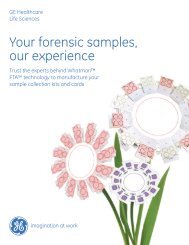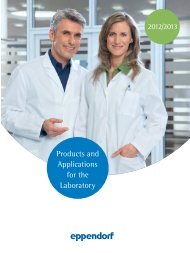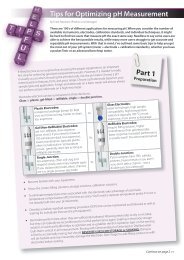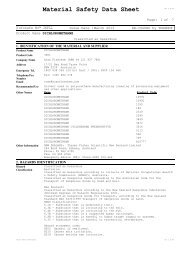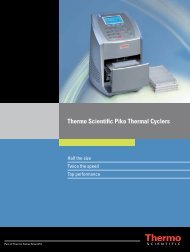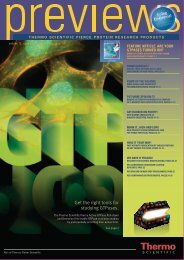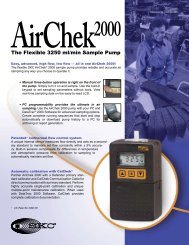Issue 1 - Thermo Fisher
Issue 1 - Thermo Fisher
Issue 1 - Thermo Fisher
You also want an ePaper? Increase the reach of your titles
YUMPU automatically turns print PDFs into web optimized ePapers that Google loves.
Article<br />
Choosing the Right Centrifuge for Your Application<br />
Ms. Goodman – Sample Preparation and Separations Applications Product Manager, <strong>Thermo</strong> <strong>Fisher</strong> Scientific Inc<br />
Figure 1–Superspeed centrifuges are an excellent choice for multiuser, multiprotocol environments, offering high capacity, high g-forces, and a broad range of rotors and accessories.<br />
With so many recent advances in both science and<br />
technology, it is wise to educate yourself about the wide<br />
range of centrifuge options now available. Following are<br />
some key questions that can be used to determine the<br />
type of centrifuge that will best meet your needs:<br />
1. What applications and protocols will the centrifuge<br />
be used to support?<br />
2. What are the maximum and minimum g-force<br />
(relative centrifugal force, RCF) and volume<br />
requirements?<br />
3. How many tubes or samples must be processed in a<br />
run, shift, or day?<br />
4. What types of sample formats will the centrifuge<br />
need to support (i.e., microplates, blood collection<br />
tubes, disposable conical tubes)?<br />
5. What type of rotors will be needed to support your<br />
applications (i.e., fixed angle, swinging bucket)?<br />
6. How many people will be using the centrifuge?<br />
7. Is versatility important? That is, do you anticipate<br />
the need for a broad range of protocols and<br />
multiple users, or will you be performing the same<br />
standardized protocol day after day?<br />
8. Do you have any space restrictions, such as benchtop<br />
or floor space only?<br />
9. Do you have special needs such as process<br />
traceability, user lock-out, or biocontainment?<br />
10. What is your budget?<br />
Once you have answered these questions, you should<br />
have a better picture of your centrifuge requirements. It<br />
is also helpful to review the basic types of centrifuges to<br />
make sure you know which category best fits your needs.<br />
Floor model or benchtop?<br />
Centrifuges are generally classified<br />
as either floor-standing or benchtop<br />
models. The style you choose is<br />
typically determined by performance<br />
requirements, available space, and<br />
budget.Floor-model centrifuges<br />
free up bench space and are often<br />
chosen for either high-speed or<br />
high-capacity sample processing.<br />
Within the floor-model category<br />
there are superspeed centrifuges,<br />
ultracentrifuges, and low-speed<br />
centrifuges.Benchtop centrifuges<br />
offer versatility and convenience, and<br />
can be equipped to accommodate a<br />
broad range of needs, making them<br />
a cost-effective solution for many<br />
laboratories. Benchtop platforms<br />
include general-purpose centrifuges,<br />
micro- centrifuges, small clinical<br />
centrifuges, cell washers, and<br />
high-speed models.<br />
Choosing the right floormodel<br />
centrifuge<br />
Superspeed centrifuges – If you<br />
are looking for high capacity, high<br />
g-force and versatility, a super- speed<br />
centrifuge (Figure 1) is probably<br />
the best choice. Many superspeed<br />
models offer a choice of up to 40<br />
rotors, making them an excellent<br />
solution for core laboratories<br />
performing general preparative<br />
applications such as whole cell<br />
separations, protein precipitation,<br />
tissue culture, subcellular isolation<br />
(i.e., Golgi bodies, ribosomes),<br />
plasmid preps, and DNA/RNA<br />
separations. Superspeed centrifuges<br />
are also the best option for multiuser,<br />
multiprotocol environments. Their<br />
versatility enables researchers<br />
to step into new, cutting-edge<br />
technologies without purchasing a<br />
dedicated centrifuge for one specific<br />
application.<br />
Ultracentrifuges – If your<br />
application calls for g-forces of up<br />
to 1,000,000 × g, you will need an<br />
ultracentrifuge. These extremely<br />
powerful centrifuges support sample<br />
volumes up to 250mL. Within the<br />
ultracentrifuge line there are two<br />
platforms: full-size floor models,<br />
which support g-forces of up to<br />
802,000 × g and volumes up to<br />
250mL; and micro-ultracentrifuges,<br />
which support g-forces of above<br />
1,000,000 × g and microvolume<br />
samples up to 13.5mL.<br />
Common ultracentrifuge applications<br />
include the separation of virus<br />
particles; DNA, protein, or RNA<br />
fractionation; as well as lipoprotein<br />
flotation. Density and size gradient<br />
22



